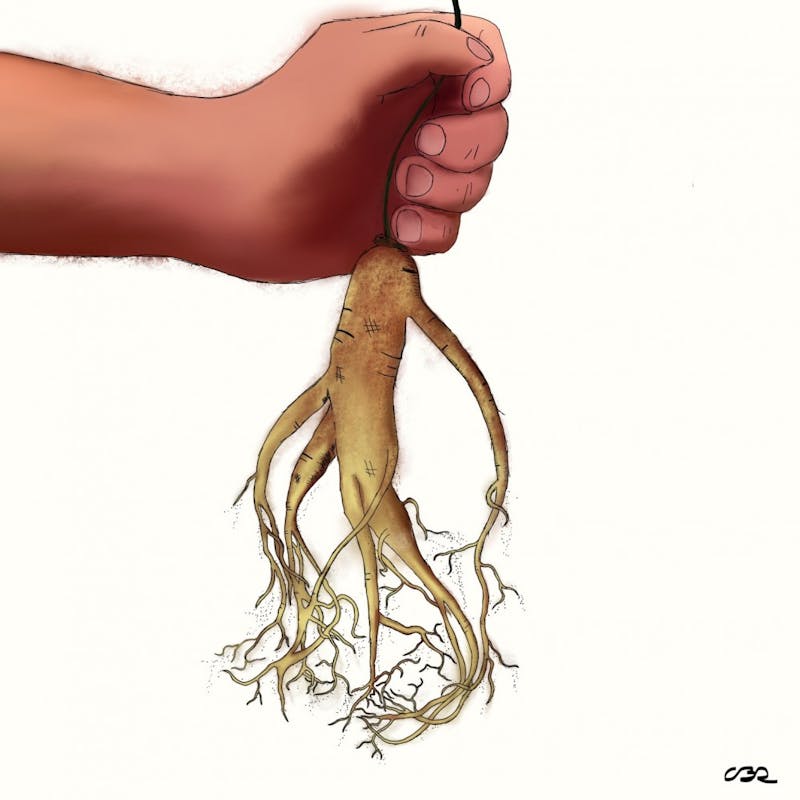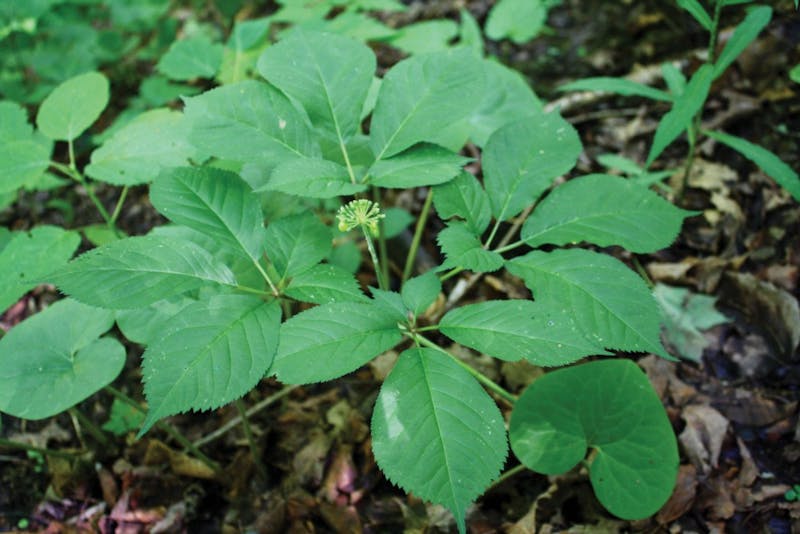


CHANCE BRINKMAN-SULL
11.16.16
Greg Duskey has always been looking. That’s what his father taught him to do, only after his father’s father taught him.
Duskey learned how to spot ginseng leaves on the forest floor of Morgan County when he was about 12 years old, how to determine their maturity and whether the root beneath them was ready to dig. Duskey loves ginseng, he said. The plant is both fun and frustrating to watch for.
But now, he’s a bit exhausted by it.
“It takes 10, 12, 14 years before it’s mature. You’ve got to get through a lot of years of people not trespassing on your property and seeing it, and somebody will come across your property looking for ginseng. Once they find it, they come back until they decimate it,” Duskey said. “At one point, I did have hundreds of thousands of dollars worth planted.”
Most property owners in Appalachia keep their knowledge of the plant and its location hushed, said Chip Carroll, sanctuary manager at United Plant Savers. Much of that secrecy is caused by the poachers who often trespass onto property, steal whatever they can spot and sell the roots to a nearby dealer to fetch the hefty sum that has earned wild American ginseng the title of “Ohio’s green gold.”
Wild American ginseng — native to forests in the Midwest, Appalachian and Northeast regions — has historically been harvested for traditional herbal medicines and is typically shipped to Hong Kong and China, according to a fact sheet from the U.S. Fish and Wildlife Service agency. Harvesting wild American ginseng for Asian markets dates back to the mid-1700s, and although ginseng can be field-cultivated under artificial shade, wild American ginseng — distinguishable by its more gnarled root — is worth far more as a medicinal herb in Asian countries.
“I think wild ginseng in Asia is very rare, so they came here and they found the same type of root — higher quality, even — than what they had,” Melissa Moser, ginseng permit coordinator and researcher for the Ohio Division of Wildlife, said. “They have a lot of pollution over there, so that makes our ginseng even more valuable.”

Provided via Greg Duskey
Dried ginseng is used for its medicinal properties and can be sold for thousands of dollars.
The current going rate for a pound of wild dry, mature ginseng — which can be sold to one of Ohio’s roughly 60 permitted ginseng dealers — ranges from $300 to $500, and the root has fetched up to $1,000 per pound in previous years. One pound of dry ginseng can hold more than 300 roots.
Carroll pointed to a seller on the online marketplace Etsy, Bat Cave Botanicals, which is marketing a single root from a wild ginseng plant dug in North Carolina for $5,000.
Such high price tags have attracted some unwanted attention, though.
“Almost every grower that I’ve ever worked with in southeast Ohio has experienced theft,” Carroll, who has maintained a successful 17-year-old wild and wild-simulated ginseng operation in Meigs County, said.
Though state ginseng dealers have to be registered and approved annually through the Ohio Division of Wildlife — and have to obtain an export permit from the U.S. Fish and Wildlife Service agency before shipping internationally — ginseng diggers operate independently and without permit, making the digging process hard to precisely track. So, ginseng dealers are left with the brunt of the responsibility in determining whether they trust that those who are bringing them wild American ginseng are doing so ethically. Too often, Carroll said, that is not the case.
Duskey agreed, but he added that little can be done to further regulate the sale of ginseng from digger to dealer.
“Diggers have to keep track of when the ginseng is dug, what county it’s dug in, and they have to have it certified before it leaves Ohio,” Moser said. “It’s certified by an Ohio Division of Wildlife employee, and (the diggers) have to bring all of their paperwork, but we’re only asking for accounting information and not specific landowner information.”
Ginseng’s worth and its rise in popular culture made it one of the more talked about plants at a workshop and conference for forest farmers and woodland owners, hosted at the United Plant Savers Goldenseal Sanctuary from Sept. 23 to Sept. 25 in Rutland.
Carroll, addressing a crowd of workshop attendees at the sanctuary, simply asked those in the room to look past the groaned-over History Channel reality television show Appalachian Outlaws, and the perception it has fostered about Appalachia as a region where, according to its website, “401Ks aren’t built on mutual funds, but on ginseng, animal furs and moonshine.”
The plant has deep roots in Appalachian culture and history, he said, but the perception of the plant being “easy money” has made those with ginseng on their property susceptible to theft from drug addicts and criminals looking for quick cash. What some fail to realize is that they’re stealing income directly from property owners. One year, Duskey saw $10,000 worth of ginseng root stolen from his property.
Jay Abele, law enforcement supervisor for district four of the Ohio Division of Wildlife — which includes Athens County — said ginseng has been seen as “currency” in southeast Ohio, adding that where his department has found ginseng theft, it has also found drug use. He added that harvesting ginseng without permission is considered a first-degree misdemeanor.
“You can drive down a road and see a vehicle parked alongside it and think they’re hiking … but in reality they’re harvesting ginseng,” Abele said. “You need to know what to look for.”

Provided via Rural Action
Ginseng can be found throughout most of Ohio, but is most prevalent in the Appalachian region of the state.
A wild ginseng plant is usually considered mature when it is at least five years old and sports three to four prongs with a cluster of dark red berries at its center. A dealer or digger can also determine the age of a ginseng plant by counting the number of stem scars on its rhizome, also known as the “root neck,” according to the U.S. Fish and Wildlife Service’s website. For each year of growth, a ginseng root will develop a stem scar — making a mature root detectable by its four stem scars.
The plant is protected through the Convention on International Trade in Endangered Species of Wild Fauna and Flora, which mandates each state exporting wild roots pass its own regulations to ensure the plant population remains stable and ginseng is inspected and approved by a government official before shipment.
According to Ohio’s most recent export report to CITES, about 4,150 pounds of wild dry ginseng and 2,400 pounds of wild green ginseng were harvested in the 2015 growing season, which began Sept. 1 and ended Dec. 31. Ohio counties with the highest wild ginseng yields included Adams, Pike, Perry, Ross and Athens. During a good year, Ohioans might harvest more than 1.5 million ginseng plants, according to the CITES report.
From April 1, 2015 to March 31, 127 ginseng-related violations were documented by the state. 51 of those reports were for hunting ginseng without permission.
“With the television shows that are kind of romanticizing and promoting people with promises of getting rich quick and hitting the woods, people are digging indiscriminately roots that aren’t mature enough yet,” said John Stock, outreach coordinator for United Plant Savers.
Some of those with wild ginseng growing on their property have taken to installing video cameras to monitor their ginseng or have told their local wildlife officers to monitor their forest growth, Carroll said, while others have found their homeowner’s insurance will cover plant theft. Because ginseng poachers are organizing and banding together, it is important growers stick together, too.
Keeping one’s operation a secret could also make it difficult to prosecute a ginseng thief in the future, Carroll said. Still, many have taken policing their wild ginseng into their own hands. In 2012, an Ohio man even shot and killed a ginseng thief, according to Foreign Policy.
Abele said property owners do not necessarily have to make their family or neighbors aware they have ginseng growing on their property, though they could just ask those nearby to keep an eye out for suspicious vehicles or trespassers.
“If ginseng growing was simple, everyone would do it,” Carroll warned during his presentation at United Plant Savers. “The real take-home, I think, is that what’s often painted is that this is some kind of get-rich-quick scheme. It’s by no means that. It takes hard work, it takes time to be successful in producing this type of product. It takes research.”